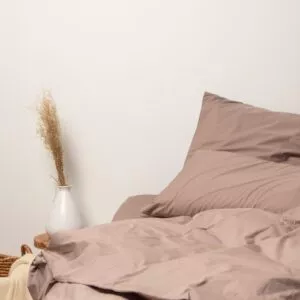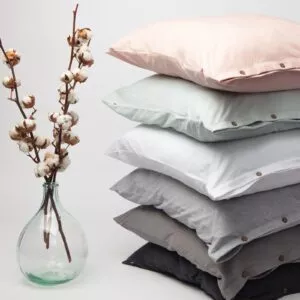Categories
Recent Posts
How to choose your bed linen to increase your well-being?
- Audrey
- 2 Comments

It was my student life, filled with stress, criticism and negativity, that led me down the parallel path of mental health. I was so passionate about the relationship between the body and the brain that I thought about dropping architecture. And then one day… I discovered ‘neuro-architecture’, a discipline that seeks to understand how space impacts our brain. That’s when BetterAtHome was born, with the main objective of creating living spaces that are as aligned as possible with our deepest needs.
Architecture and well-being, which seemed so incompatible at first, now seem inseparable…
Kalani and BetterAtHome have a common goal: to improve sleep quality in a sustainable way. A large part of BetterAtHome’s expertise consists of analysing the design of bedrooms, for a better sleep and more harmony. It is this common mission that has prompted us to write this article and explain the link between your choice of bed linen and the quality of your sleep.
Today, the main criteria for choosing bedding are mainly the colour and price of the sheets. However, the choice of a good bedding goes far beyond its aesthetic aspect and if investing in your sleep seems futile or negligible, it is not, because bed linen increase well-being! We spend 1/3 of our time in bed, so if there is one room where comfort is paramount, it is your bedroom!
The link between bedding and sleep
Even today, too many people live with the belief that sleep is useless, that sleep is a waste of time. Yet sleep is the basis for a harmonious life. You should know that ‘sleeping well’, meaning a minimum number of hours, does not necessarily mean having ‘restful sleep’. It is perfectly possible to sleep 8 hours a night without getting quality sleep.
The basis for restful sleep is that our subconscious brain feels safe. This is why the position of the bed in the room is so important. Paradoxically, it is all too often neglected. Some positions do not allow the subconscious mind to feel safe.
Bedding is the first contact with the skin. When you get into bed at the end of a long day, it is the first signal to your body and brain that it is time to switch off. Bed linen increase well-being and, symbolically, the more you like the bedding you sleep in, the more comfortable you feel in your sheets, the more you send a signal to your body to relax. Children all have pre-bedtime rituals (a story, music, …), their brain understands that it is time to sleep and the body relaxes. As adults, we have lost this habit. But by creating a feeling of satisfaction when we slip under our sheets, we automatically release the tensions of the day and provide ourselves with the conditions for disconnection.
Your bedding encompasses your whole body, the better and more pleasant it is, the more you create that feeling of protection and security that the brain needs to enter into a deep and quality sleep.
The importance of colour
Most of the time, if one does not pay attention to these aspects, aesthetics are still more important than well-being. We choose the colours of our bedding according to trends, fashion and what we like. But the colour of your sheets can influence the quality of your sleep, your body temperature, the harmony of the couple and the level of nervousness and stress, as we said bed linen increase well-being.
Where does the psychology of colour come from? Let’s talk about the laws of nature: the element that gives cold in nature is snow, which is white. White is the coldest colour, followed by blue (water). On the other hand, what makes nature warm is the sun, i.e. fire. We are talking about the colours yellow, orange and red. This explains why a room painted red will naturally be one or two degrees warmer than average. Conversely, a room painted entirely white or blue will be colder.
(A word on the fact that cold is better than warmth for sleeping?)
And when it comes to sleep, it’s always better to be too cold than too hot.
While it is true that a cool room (18°) is conducive to better sleep, an “energetically cold” room may have undesired effects on the subconscious. All these “generalities”, in the context of colour psychology, should obviously be taken with a grain of salt and in a global context. This is why it is a fascinating and powerful discipline in its own right for those who wish to approach their home and living space in this way.
To illustrate this, I give some concrete examples a little further down in this article.
The pillowcase, the cushion on which we sleep, is the most important influence on sleep.
We think that we only perceive colours through our eyes, but in reality we also perceive them through our ancient fontanelles, behind the skull. Colours are therefore not only a visual phenomenon, they are also an energetic phenomenon and they give off a vibration. The stronger and more intense the colour on the cushion, the more sleep will be disturbed. I suggest you avoid red pillowcases, red is a colour that activates the nervous system and you risk having too much energy before going to sleep.
Colour also influences reflection. There are colours that, in their vibrations, connect us to work for example. The more difficult it is for the brain to disconnect, the more difficult it is to relax.
There is no set formula
Bed linen increase well-being but it is not a question of giving you a ready-made formula, recommending one colour at all costs or advising against one colour absolutely. Some people are in a period of their life where they need one colour more than another.
Here are a few examples… To be taken with a pinch of salt, as each person is different.
The colour of the skin (pink, salmon, apricot orange) is an excellent colour for a wellness sheet. It is a soothing colour and strongly promotes sleep. It is also the colour of the inside of the womb, which the foetus perceives during the 9 months of gestation.
It is therefore a good colour if everything went well during this period of life.
On the other hand, if the mother experienced great stress during gestation, such as a separation, the foetus experienced this stress (as a baby, it may even externalise it in the form of a skin problem) and therefore associated this colour with this trauma. In this case, sheets of this colour should be avoided, as this will only reinforce the skin problems in question.
The colour blue decreases the body temperature by some milli-degrees. Especially the female body temperature (hormones more sensitive to these changes). The thermal shock between the man and the woman is too great for the spermatozoon and therefore has difficulty surviving. The colour of the sheets will therefore not promote gestation or libido. But for women who use natural contraception… perhaps it would be interesting to consider blue sheets a few days a month?
White is a colour that reinforces the feeling of loneliness. White sheets are very interesting in combination with other colour vibrations in the room, they bring balance and calm. On the other hand, more than 50% of the population has what is called an ignored twin pregnancy (two foetuses at the beginning of gestation). The cells of the foetus retain the fact that there were two of them, which explains the number of people who suffer from extreme loneliness without understanding why. In this case, too much white will reinforce this feeling of loneliness.
These examples show you how different we all are according to our experience, our history and that it is impossible to advise one colour for all. If you have several sets of sheets, I suggest that you pay attention to your energy and how you feel when you sleep in one and then in another, you will most likely feel a difference in vibration and soothing.
If these examples speak to you, or if you want to better understand your energy or what is going on, I offer personalised advice on the whole room, to determine if it is conducive to quality sleep, or not, and what colours to use to promote and find balance for each person (alone or as a couple). I also do this for babies and children, where sleep can be a real problem and affect the whole family.
More info on :
https://www.betterathome.be/chambreb%C3%A9b%C3%A9etenfant
https://www.instagram.com/betterathome.fiona/


2 Responses
Hello. What colour sheets would you recommend for someone who has anxiety and panic attacks. Your suggestions would be greatly appreciated. Damien.
Dear Damien, colour therapist recommend to sleep in pale pink or lilac bed sheets. Even if most of people sleep in the dark with closed eyes, the colour of your bad sheets has a direct impact of the anxiety and can help. Otherwise if you contact us by e-mail on info@kalani-home.com we can provide you the contact of neuro architects who work on Feng shui and home therapy to provide custom made advices based on the precise problem and the precise home/bedroom architecture, wall colours, bed direction, bed position, etc … they do miracles. Kind regards. Bruno